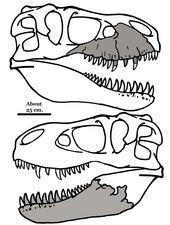
Tyrannosaurus is a genus of large theropod dinosaur. The type species Tyrannosaurus rex, often shortened to T. rex or colloquially T-Rex, is one of the best represented theropods. It lived throughout what is now western North America, on what was then an island continent known as Laramidia. Tyrannosaurus had a much wider range than other tyrannosaurids. Fossils are found in a variety of rock formations dating to the latest Campanian-Maastrichtian ages of the Late Cretaceous period, 72.7 to 66 million years ago. It was the last known member of the tyrannosaurids and among the last non-avian dinosaurs to exist before the Cretaceous–Paleogene extinction event.

Tyrannosauridae is a family of coelurosaurian theropod dinosaurs that comprises two subfamilies containing up to thirteen genera, including the eponymous Tyrannosaurus. The exact number of genera is controversial, with some experts recognizing as few as three. All of these animals lived near the end of the Cretaceous Period and their fossils have been found only in North America and Asia.
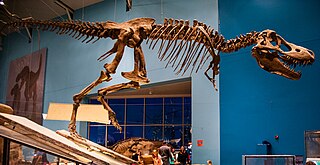
Tarbosaurus is a genus of tyrannosaurine theropod dinosaur that lived in Asia about 82 - 68 million years ago, during the Maastrichtian age at the end of the Late Cretaceous period, considered to contain a single known species: Tarbosaurus bataar. Fossils have been recovered from the Nemegt and Djadochta Formations of Mongolia, with more fragmentary remains found further afield in the Subashi Formation of China and the Jingangkou Formation of South Korea, along the South Korean Peninsula.
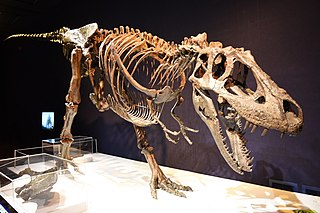
Daspletosaurus is a genus of tyrannosaurid dinosaur that lived in Laramidia between about 78 and 74.4 million years ago, during the Late Cretaceous Period. The genus Daspletosaurus contains three named species. Fossils of the earlier type species, D. torosus, have been found in Alberta, while fossils of a later species, D. horneri, have been found only in Montana. D. wilsoni has been suggested as an intermediate species between D. torosus and D. horneri that evolved through anagenesis, but this theory has been disputed by other researchers.

Tyrannosauroidea is a superfamily of coelurosaurian theropod dinosaurs that includes the family Tyrannosauridae as well as more basal relatives. Tyrannosauroids lived on the Laurasian supercontinent beginning in the Jurassic Period. By the end of the Cretaceous Period, tyrannosauroids were the dominant large predators in the Northern Hemisphere, culminating in the gigantic Tyrannosaurus. Fossils of tyrannosauroids have been recovered on what are now the continents of North America, Europe and Asia, with fragmentary remains possibly attributable to tyrannosaurs also known from South America and Australia.

Tyrannosaurinae is one of the two extinct subfamilies of Tyrannosauridae, a family of coelurosaurian theropods that consists of at least three tribes and several genera. All fossils of these genera have been found in the Late Cretaceous deposits of western North America and east Asia. Compared to the related subfamily Albertosaurinae, tyrannosaurines overall are more robust and larger though the alioramins were gracile by comparison. This subfamily also includes the oldest known tyrannosaurid genus Lythronax as well as the youngest and most famous member of the group, Tyrannosaurus rex. There were at least 30 different species of tyrannosaurines.

Proceratosauridae is a family or clade of tyrannosauroid theropod dinosaurs from the Middle Jurassic to the Early Cretaceous.

Bistahieversor, also known as the "Bisti Beast", is a genus of basal eutyrannosaurian theropod dinosaur. The genus contains only a single known species, B. sealeyi, described in 2010, from the Late Cretaceous of New Mexico. The holotype and a juvenile were found in the Hunter Wash Member of the Kirtland Formation, while other specimens came from the underlying Fossil Forest member of the Fruitland Formation. This dates Bistahieversor approximately 75.5 to 74.5 million years ago during the Campanian age, found in sediments spanning a million years.
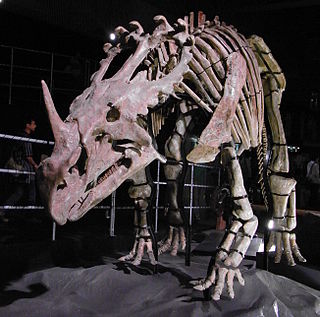
Sinoceratops is an extinct genus of ceratopsian dinosaur that lived approximately 73 million years ago during the latter part of the Cretaceous Period in what is now Shandong province in China. It was named in 2010 by Xu Xing et al. for three skulls from Zhucheng, China. The name of its type species Sinoceratops zhuchengensis means "Chinese horned face from Zhucheng", after the location of its discovery.

Teratophoneus is a genus of tyrannosaurine theropod dinosaur that lived during the late Campanian age of the Late Cretaceous period, in what is now Utah. It contains a single known species, T. curriei. It is known from an incomplete skull and postcranial skeleton recovered from the Kaiparowits Formation and was specifically named T. curriei in honor of famed paleontologist Philip J. Currie.
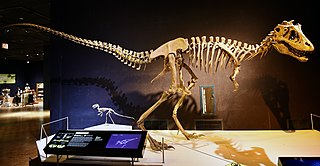
Lythronax is a genus of tyrannosaurid dinosaur that lived in North America around 81.9-81.5 million years ago during the Late Cretaceous period. The only known specimen was discovered in Utah in the Wahweap Formation of the Grand Staircase–Escalante National Monument in 2009, and it consists of a partial skull and skeleton. In 2013, it became the basis of the new genus and species Lythronax argestes; the generic name Lythronax means "gore king", and the specific name argestes originates from the Greek poet Homer's name for the wind from the southwest, in reference to the specimen's geographic provenance in North America.
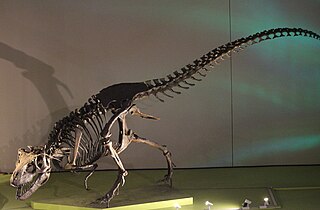
Nanuqsaurus is a genus of tyrannosaurine theropod dinosaur known from the Late Cretaceous period Prince Creek Formation of the North Slope of Alaska, having lived roughly 70-68 million years ago. It contains a single species, Nanuqsaurus hoglundi, known only from a partial skull and multiple undescribed postcranial and teeth elements.

Alioramini is a tribe of long-snouted tyrannosaurine tyrannosaurids from the Late Cretaceous epoch. It includes the tyrannosaurid genera Alioramus and Qianzhousaurus. Although tyrannosaurids are known from a variety of places around the globe, alioramins are currently restricted to Asia in mostly Maastrichtian strata. Many of the fossils attributed to Alioramini are not from fully developed individuals.

This timeline of tyrannosaur research is a chronological listing of events in the history of paleontology focused on the tyrannosaurs, a group of predatory theropod dinosaurs that began as small, long-armed bird-like creatures with elaborate cranial ornamentation but achieved apex predator status during the Late Cretaceous as their arms shrank and body size expanded. Although formally trained scientists did not begin to study tyrannosaur fossils until the mid-19th century, these remains may have been discovered by Native Americans and interpreted through a mythological lens. The Montana Crow tradition about thunder birds with two claws on their feet may have been inspired by isolated tyrannosaurid forelimbs found locally. Other legends possibly inspired by tyrannosaur remains include Cheyenne stories about a mythical creature called the Ahke, and Delaware stories about smoking the bones of ancient monsters to have wishes granted.
Zhuchengtitan is a genus of titanosaurian sauropod dinosaur from the Late Cretaceous of Shandong, China. It contains a single species, Z. zangjiazhuangensis, named by Mo Jinyou and colleagues in 2017 from a single humerus. Zhuchengtitan can be identified by the extreme width of the top end of its humerus, as well as the expansion of the deltopectoral crest on its humerus; both of these characteristics indicate that it was likely closely related to Opisthocoelicaudia. However, it differs from the latter by the flatter bottom articulating surface of its humerus. Zhuchengtitan lived in a floodplain environment alongside Shantungosaurus, Zhuchengtyrannus, and Sinoceratops.

Eutyrannosauria is a clade of tyrannosauroid theropods whose distribution has been found in what is now Asia and North America. The clade consists of an evolutionary grade of tyrannosaurs such as Appalachiosaurus, Dryptosaurus, and Bistahieversor which led up to the family Tyrannosauridae. The group was named in 2018 by Delcourt and Grillo in their paper about possible southern hemisphere tyrannosauroids and the phylogeography of tyrannosaurs.

Dynamoterror is a monospecific genus of tyrannosaurid dinosaur from New Mexico that lived during the Late Cretaceous in what is now the upper Allison Member of the Menefee Formation. The type and only species, Dynamoterror dynastes, is known from a subadult or adult individual about 9 metres long with an incomplete associated skeleton. It was named in 2018 by Andrew T. McDonald, Douglas G. Wolfe and Alton C. Dooley, Jr. Dynamoterror was closely related to Teratophoneus and Lythronax.

Thanatotheristes is a genus of tyrannosaurid dinosaur from the Late Cretaceous of Laramidia, approximately 80.1-79.5 Ma. Thanatotheristes contains only one species, T. degrootorum. Fossils of this taxon are found in the Foremost Formation of Alberta, Canada, coexisting with medium-sized ceratopsids like Xenoceratops foremostensis and small pachycephalosaurids like Colepiocephale lambei.

Daspletosaurini is an extinct clade of tyrannosaurine dinosaurs that lived in Laramidia during the Late Cretaceous period. It consists of two genera: Daspletosaurus and Thanatotheristes. Four species have been described in the two genera, namely Daspletosaurus torosus, Daspletosaurus horneri, Daspletosaurus wilsoni, and Thanatotheristes degrootorum. At one point all of them were assigned as specimens of D. torosus, but several papers since 2017 have found them to represent distinct species. Some researchers found anagenesis in the group, whether contained in a daspletosaurin clade or paraphyletic in respect to the lineage of tyrannosaurines leading up to Tyrannosaurus, but a 2023 study refuted this theory on the basis of morphological and stratigraphical data.
Sinankylosaurus is a genus of dinosaur, originally described as an ankylosaur, from the Late Cretaceous Hongtuya Formation of Shandong, China. The genus contains a single species, Sinankylosaurus zhuchengensis, known from a nearly complete right ilium. The describers claim that the discovery of Sinankylosaurus further demonstrates the similarity between dinosaurs of eastern Asia and western North America.

